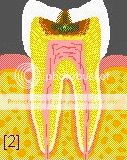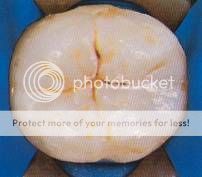- My Forums
- Tiger Rant
- LSU Recruiting
- SEC Rant
- Saints Talk
- Pelicans Talk
- More Sports Board
- Fantasy Sports
- Golf Board
- Soccer Board
- O-T Lounge
- Tech Board
- Home/Garden Board
- Outdoor Board
- Health/Fitness Board
- Movie/TV Board
- Book Board
- Music Board
- Political Talk
- Money Talk
- Fark Board
- Gaming Board
- Travel Board
- Food/Drink Board
- Ticket Exchange
- TD Help Board
Customize My Forums- View All Forums
- Show Left Links
- Topic Sort Options
- Trending Topics
- Recent Topics
- Active Topics
Started By
Message
re: OT Dentists - Over-diagnosing cavities
Posted on 6/17/15 at 10:58 am to 911Moto
Posted on 6/17/15 at 10:58 am to 911Moto
Here's a quick lesson in reference to judgment calls:

There's the outer layer of enamel surrounding the underlying softer dentin in a tooth. Once bacteria/decay works its way through the enamel, it spreads out quicker when it hits the dentin. Thus, what may appear to be a negligible lesion on the surface can actually be significant decay underneath.
Enamel has the ability to remineralize, so an incipient lesion on the surface may have the ability to heal or be healed through assistance. Yet with there being abundant sources of fluoride in modern times, this can cause diagnostic issues. In the "old" days, you could rely on a probe - if it sticks in the tooth, you have a cavity. But with our ability to rapidly remineralize enamel with the aid of fluoride, in modern times you have instances where the enamel may remineralize and appear "healed" on the surface, yet it may be hiding decay underneath in the dentin. This leads to more judgment calls today than there were decades ago.
Let's say your dentist sees this:

In the old days, most dentists might say "if the probe doesn't stick, watch it or maybe seal it." But you could actually just be sealing the decay in - thus hiding your ability to determine if it worsens. Or if they watch it and the patient doesn't return for a couple years, they just watched it turn into a large cavity. In modern dentistry, there are more "in between" options. You could lightly hit the grooves with a very small bur, and if the decay or stain doesn't get further than the surface enamel, you can put a small filling or sealant that is tooth colored and actually continues to release fluoride into the area. Or you don't even need to drill - you could do the same thing with air abrasion.But you also have more diagnostic options than your eye and a probe - you could use a diagnostic tool that uses a laser to measure fluorescence in the enamel to determine if decay is actually present.
Everything is not cut and dry in dentistry, and there are several approaches which can be used to a potential problem without there being a definitive right or wrong answer. I'm busting Ruzil's balls since he doesn't know how to run a hygiene program and feels like he's doing people a favor by offering the most basic of services, but he's right on most of what he said. Judgment and a thorough medical/habit history go a long way. Bottom line: always question your dentist, have them show you instead of tell you, and get a second opinion when in doubt. There are more scumbags out there than most dentists will admit to.

There's the outer layer of enamel surrounding the underlying softer dentin in a tooth. Once bacteria/decay works its way through the enamel, it spreads out quicker when it hits the dentin. Thus, what may appear to be a negligible lesion on the surface can actually be significant decay underneath.
Enamel has the ability to remineralize, so an incipient lesion on the surface may have the ability to heal or be healed through assistance. Yet with there being abundant sources of fluoride in modern times, this can cause diagnostic issues. In the "old" days, you could rely on a probe - if it sticks in the tooth, you have a cavity. But with our ability to rapidly remineralize enamel with the aid of fluoride, in modern times you have instances where the enamel may remineralize and appear "healed" on the surface, yet it may be hiding decay underneath in the dentin. This leads to more judgment calls today than there were decades ago.
Let's say your dentist sees this:

In the old days, most dentists might say "if the probe doesn't stick, watch it or maybe seal it." But you could actually just be sealing the decay in - thus hiding your ability to determine if it worsens. Or if they watch it and the patient doesn't return for a couple years, they just watched it turn into a large cavity. In modern dentistry, there are more "in between" options. You could lightly hit the grooves with a very small bur, and if the decay or stain doesn't get further than the surface enamel, you can put a small filling or sealant that is tooth colored and actually continues to release fluoride into the area. Or you don't even need to drill - you could do the same thing with air abrasion.But you also have more diagnostic options than your eye and a probe - you could use a diagnostic tool that uses a laser to measure fluorescence in the enamel to determine if decay is actually present.
Everything is not cut and dry in dentistry, and there are several approaches which can be used to a potential problem without there being a definitive right or wrong answer. I'm busting Ruzil's balls since he doesn't know how to run a hygiene program and feels like he's doing people a favor by offering the most basic of services, but he's right on most of what he said. Judgment and a thorough medical/habit history go a long way. Bottom line: always question your dentist, have them show you instead of tell you, and get a second opinion when in doubt. There are more scumbags out there than most dentists will admit to.
This post was edited on 6/17/15 at 11:00 am
Popular
Back to top
 0
0





